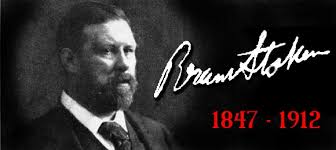
20 April 1912: The death of Bram Stoker, author of the horror novel Dracula on this day in London England. Abraham "Bram" Stoker (8 November 1847 – 20 April 1912) was an Anglo-Irish novelist and short story writer. During his lifetime, he was better known as personal assistant of actor Henry Irving and business manager of the Lyceum Theatre in London, which Irving owned.
Stoker was born on 8 November 1847 at 15 Marino Crescent, Clontarf , Dublin. His parents were Abraham Stoker (1799–1876), from Dublin, and Charlotte Mathilda Blake Thornley (1818–1901), Stoker was the third of seven children. Abraham and Charlotte were members of the Church of Ireland and Bram was babtised in the local COI church.
Stoker was bedridden with an unknown illness until he started school at the age of seven, when he made a complete recovery. Of this time, Stoker wrote, "I was naturally thoughtful, and the leisure of long illness gave opportunity for many thoughts which were fruitful according to their kind in later years." He was educated in a private school run by the Rev. William Woods.
After his recovery, he grew up without further major health issues, even excelling as an athlete (he was named University Athlete) at Trinity College Dublin, which he attended from 1864 to 1870. He graduated with honours as a BA in Mathematics. He was auditor of the College Historical Society ('the Hist') and president of the University Philisophical Society, where his first paper was on "Sensationalism in Fiction and Society".
While manager for Irving and secretary and director of London's Lyceum Theatre, he began writing novels, beginning with The Snakes Pass in 1890 and Dracula in 1897. During this period, Stoker was part of the literary staff of the The Daily Telegraph in London, and wrote other fiction, including the horror novels The Lady in the Shroud (1909) and The Lair of the White Worm (1911). In 1906, after Irving's death, he published his life of Irving, which proved successful.
Before writing Dracula, Stoker met Ármin Vámbéry who was a Hungarian writer and traveler. Dracula likely emerged from Vámbéry's dark stories of the Carpathian mountains.Stoker then spent several years researching European folklore and mythological stories of vampires . Dracula is written as a collection of realistic, but completely fictional, diary entries, telegrams, letters, ship's logs, and newspaper clippings, all of which added a level of detailed realism to his story, a skill he developed as a newspaper writer. At the time of its publication, Dracula was considered a "straightforward horror novel" based on imaginary creations of supernatural life. "It gave form to a universal fantasy . . . and became a part of popular culture."
After suffering a number of strokes, Stoker died on 20 April 1912 in London. He was cremated , and his ashes placed in a display urn at Golders Green Crematorium. After Irving Noel Stoker's death in 1961, his ashes were added to that urn. The original plan had been to keep his parents' ashes together, but after Florence Stoker's death, her ashes were scattered at the Gardens of Rest. To visit his remains at Golders Green, visitors must be escorted to the room the urn is housed in, for fear of vandalism.